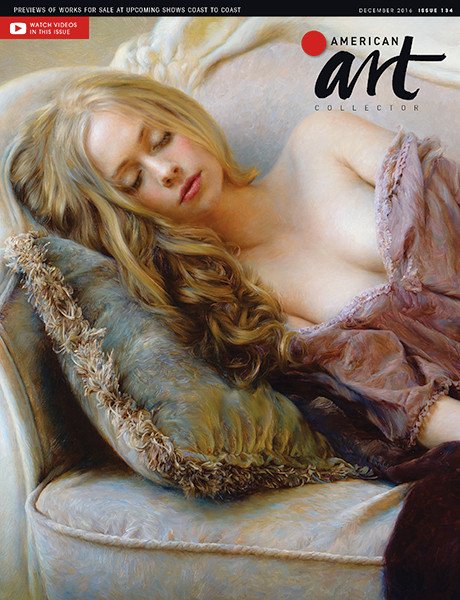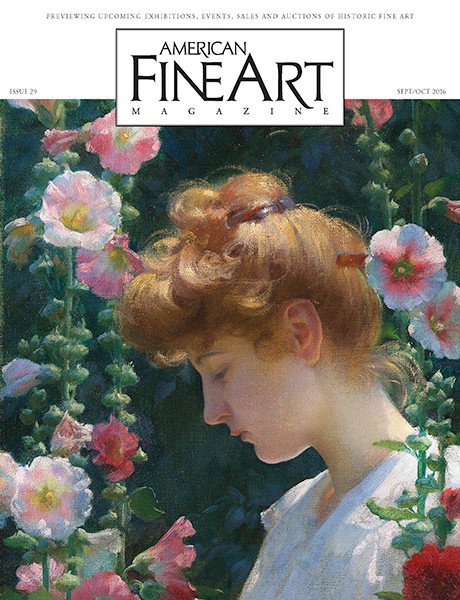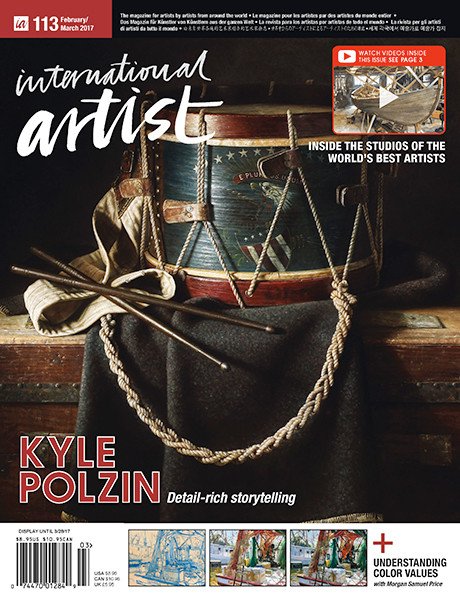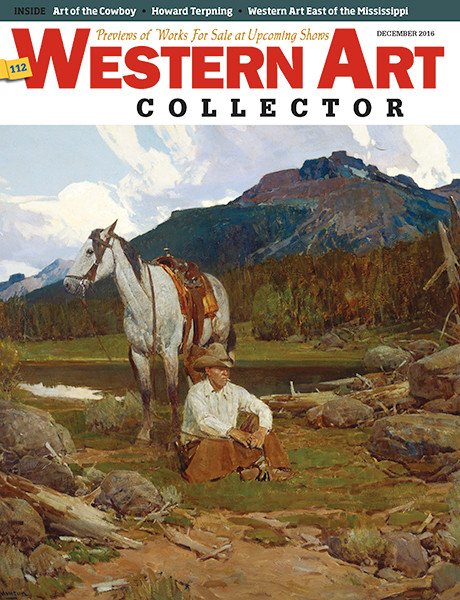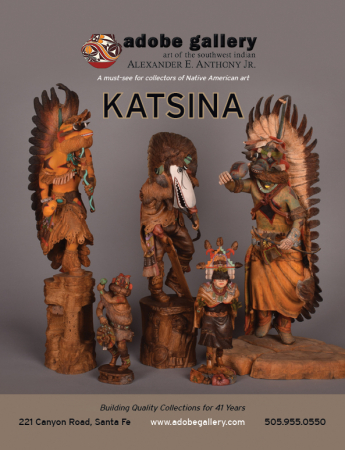Adobe Gallery
221 Canyon RoadSanta Fe, NM 87501
505-955-0550
Email this Gallery
Visit Gallery Website
Southwestern Landscapes and Portraits by New Mexico Artists
1/10/2020 - 2/28/2020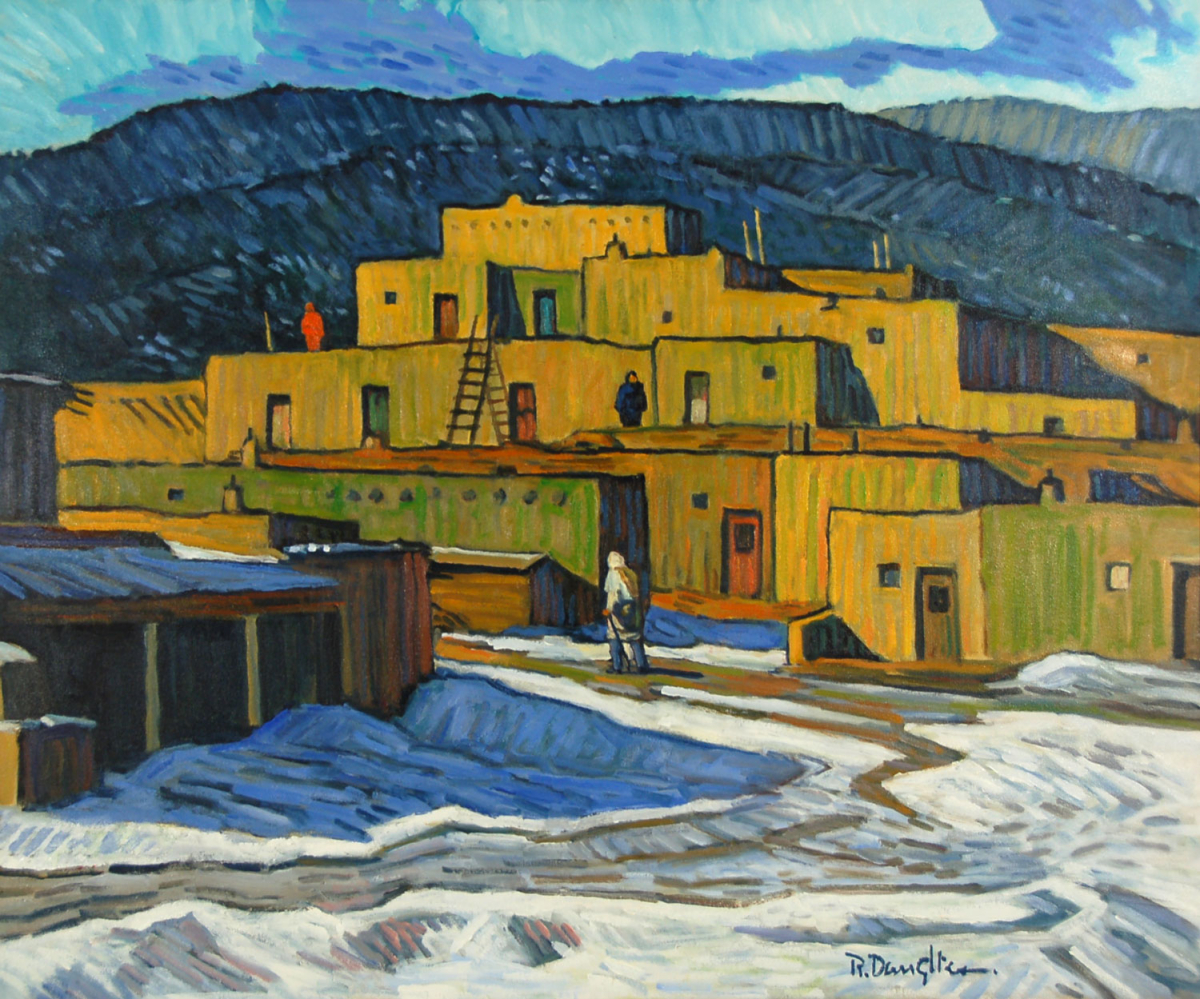
“Pueblo View – Winter”
Robert Daughters (1929-2013)
oil on canvas
25 x 30 inches (L x W)
Robert Daughters' (1929-2013) paintings may be defined as being in the Impressionist style, even though the artist preferred not to categorize his work to a single style. Daughters was confident when putting a scene down on canvas. He had studied the scene, determined his course of action, and began painting with assurance. Daughters would sketch the scene on canvas and then execute it in oils.
As an artist, he analyzed the subject, absorbed its abstract manners and colors and, using an artist eye, put the scene on canvas using his own expression of shapes and colors. His paintings are strong in execution of wide brush strokes in a very Van Gogh style, although Daughters would hate to hear that comparison.
This painting is obviously meant to reflect Taos Pueblo but represented in Daughters’ style, a view as interpreted by him when studying the scene. He interpreted the shapes of the buildings, the flow of the water in the river, and the colors reflecting off the buildings and snow. With these in his eye perspective, he laid his impression on the canvas.
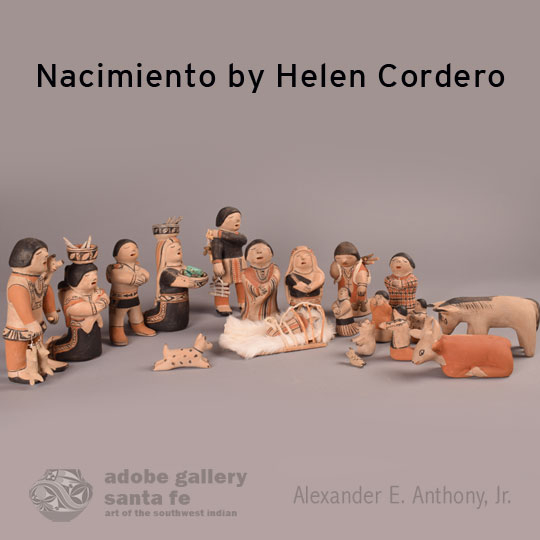
17-piece Pottery Nacimiento
Helen Cordero (1915-1994) Cochiti Pueblo
clay, pigment, goat skin, wood
6.5 x 3 inches (L x W)
In 1972, Helen Cordero made this 17-piece nacimiento for a friend in Albuquerque. The addition of children and puppies to the scene is a Helen Cordero trademark. Her cattle always bear the Cochiti brand. Her people have their eyes closed and mouths open as in all her other figurine pottery. Helen said she made nacimientos the way it is traditional at Cochiti Pueblo—the clothes they wear, the gifts they bring, and the animals of the pueblo. She never used sheep because there are none at Cochiti.
Baby Jesus is swaddled in a traditional wood cradleboard on rabbit fur. The empty bowl being carried by one female has been filled with turquoise nuggets. The small dog and bird were not part of the original set and may not have been made by Cordero, but they are included now. Photographs of this set have been included in multiple notable publications.
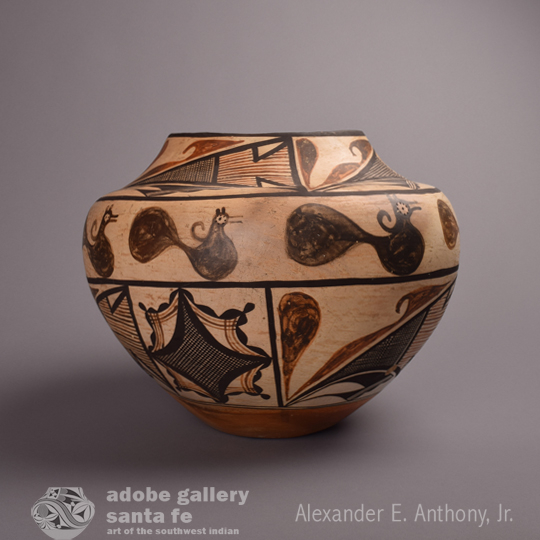
Acoma Olla with Zuni-Influenced Designs
Unknown Native Artist
clay, pigments
10.25 x 12.75 inches (L x W)
This early 1900s Acoma OLLA was decorated in its entirety in Zuni designs. For over a hundred years, Acoma potters have borrowed and reproduced Zuni designs. This trend seemed to be favorable in the 1890 to 1915 time period. Designs moved rather freely between Zuni and Acoma, no doubt due to their geographical proximity and probable historic connections.
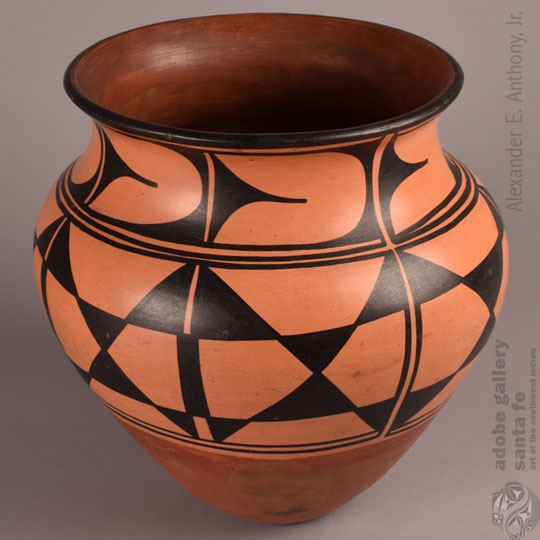
Black-on-Creamy-Red Pottery Jar
Felipita Aguilar Garcia and Asuncion Aguilar Caté, Santo Domingo Pueblo
clay, pigments
12 x 12 inches (L x W)
This Santo Domingo Pueblo pottery jar by the Aguilar sisters, with its intense black design on a creamy red background, is a highlight of their work. and not just because of its atypical color. Its shape is unusual and very appealing. It’s a bit taller than their norm, and its rim is almost as wide as the jar’s widest point. As with many of the Aguilar sisters’ jars, it looks much more modern than it actually is. This jar is unusual in that the body was covered in red slip rather than the usual cream slip. Here, it’s a bit lighter than usual. It appears almost orange under certain light sources.
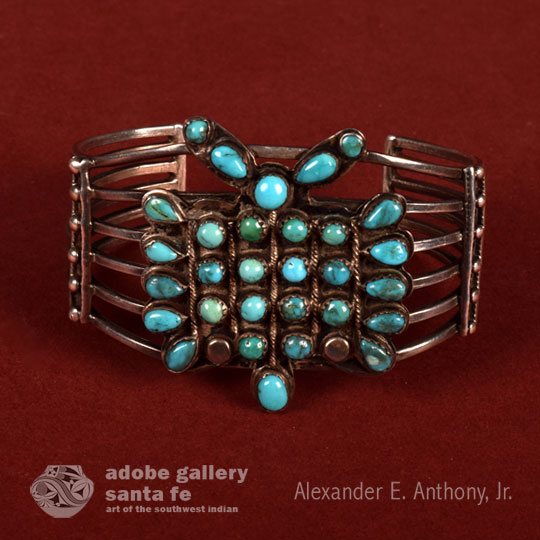
Diné Silver and Turquoise Bracelet with Butterfly Image
Unknown Native Artist
silver, turquoise
The Navajo silver and turquoise bracelet foundation was made from six silver wires which were secured with silver bars at the ends and reinforced with silver bars at the midpoint. A grouping of thirty small round and oval turquoise gemstones were arranged in the shape of a butterfly. Each turquoise cab was set securely in a serrated silver bezel. All the turquoise gemstones are in excellent condition. The bracelet dates to the early twentieth century. Approximate snug wrist size: 6-1/4"
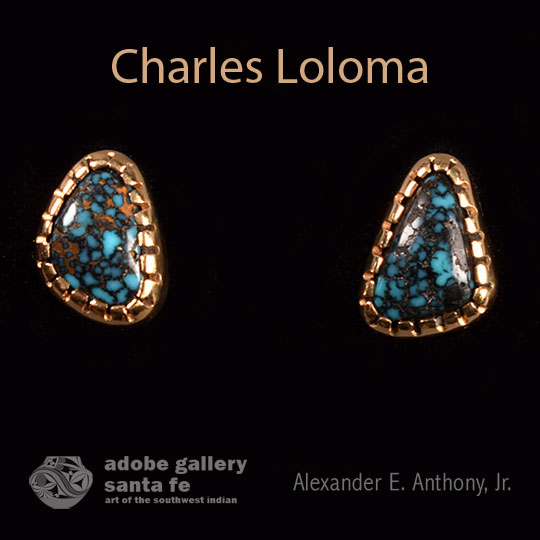
Gold Earrings with Lander Blue Turquoise
Charles Loloma (1921-1991) Hopi Pueblo
gold, Lander Blue turquoise
0.5 x 0.25 inches (L x W)
These small gold earrings by Hopi Pueblo artist Charles Loloma are an example of his creativity and technical accomplishments. Each of the earrings is host to a free-form Lander Blue Turquoise gemstone set in a gold bezel fitted for their secure protection. Each earring is stamped with the artist's name on the back side. The set appears to be in the original box in which it was issued.
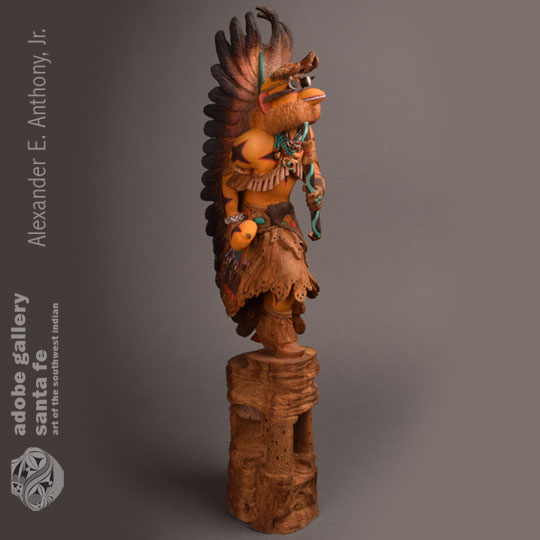
Hopi Pueblo Sikyahote - Yellow A’hote Katsina Doll
Kevin Pochoema (1965- )
wood, stains, acrylic paint
21 x 4 x 5 inches (L x W x D)
Hopi Pueblo artist Kevin Pochoema’s Yellow A’hote Katsina doll is truly spectacular. A’hote’s most immediately striking characteristic is his size. At nearly 22 inches in height—the largest Pochoema katsina doll that Adobe Gallery has ever seen. Remarkably, a single intricately carved piece of cottonwood comprises the majority of the piece. To this main piece of wood, just a few details were attached: A’hote’s bow, rattle, eyes, and three feathers. Most of A’hote’s details—which are many, and which are of particularly high quality—protrude from the main piece of wood. That means that they must be planned and executed with incredible care, as mistakes cannot be easily corrected. Pochoema’s work here is, incredibly, just as intricate as the work we see on his smaller-scale pieces. The four feathers that extend outward from the top of A’hote’s head are most impressive when the viewer is aware that they were not attached to the piece.
The doll is depicted mid-stride, carrying a bow in his left hand and a rattle in his right. His kilt and its various colorful adornments drape elegantly over his knee, as he makes a step upward. One cannot help but notice that A’hote’s colors are absolutely gorgeous. The yellow used for his chest, mask, and rattle is particularly strong. Star designs made of black and red decorate A’hote’s shoulders, arms, chest and face, complementing the rich yellow perfectly. Turquoise and gold, used primarily for A’hote’s jewelry, add a dose of bright color to the piece. A’hote’s elaborate feathered headdress merits praise, too. Each and every one of the dozens of feathers includes a series of small lines extending outward from a single line down its center. Their coloring, too, is impressive, with each feather undergoing a dramatic shift from light to dark as it extends away from the headdress’ center. Pochoema’s process for creating these feathers is quite laborious, but the results are astounding. When discussing a significantly smaller previous creation, he noted that the feathers’ lines and coloring took days to complete.
Pochoema’s Yellow A’hote stands atop an ornate base that is about 7 inches tall. The base is decorated with elaborate cliff dwellings and signed “Pochoema” next to A’hote’s right foot. According to the artist, the piece was in production for about a year and a half.
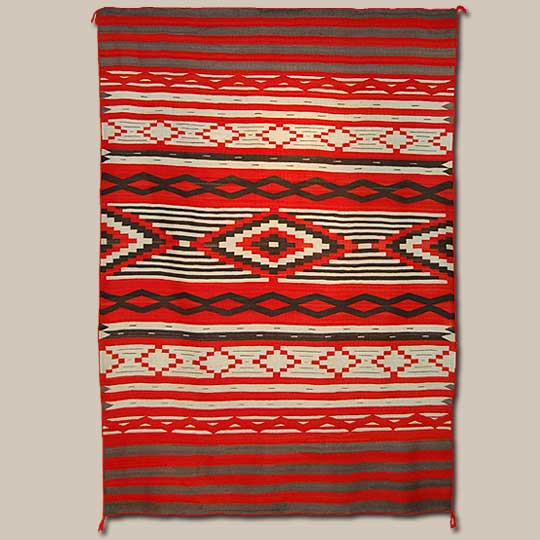
J.B. Moore Plate II Variant Crystal Trading Post Navajo Rug
Unknown Native Artist
native wool
94 x 64 inches (L x W)
This wonderful rug was made by an unknown Diné artist. J. B. Moore, Trader at Crystal Trading Post in New Mexico from 1900 to 1911 is now famous for introducing to the weavers new patterns of textiles he felt would be salable to Easterners for use as rugs. His early examples, published in a 1903 catalog, were more similar to classic Navajo textiles and those published in a 1911 catalog were more similar to Persian rugs. It was his intent to have weavers make rugs that looked familiar to Easterners. They were then using Persian carpets, so his patterns were made to be similar. His idea worked and established a market for the Navajo women’s work. Almost 100 years later, some of these rugs are still in use. This one is an example of the durability of Moore’s product and the beauty of his designs.
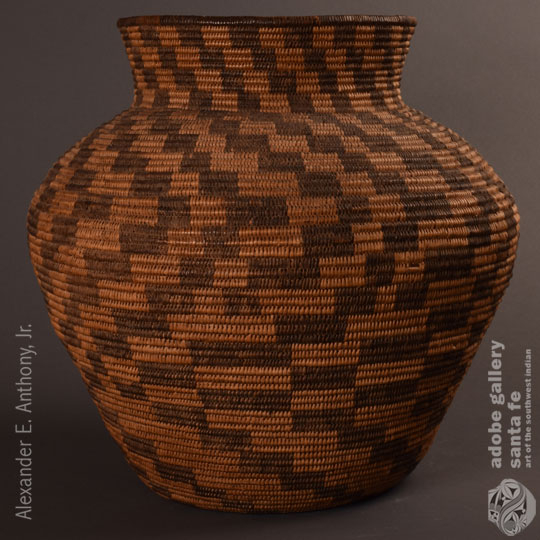
Large Turn of the Century Western Apache Basketry OLLA
Unknown Native Artist
willow, devil’s claw
14.25 x 14.5 inches (L x W)
This large Turn of the Century Western Apache Basketry OLLA dates to the turn of the 20th century, circa 1890-1910. It is constructed with a 3-rod willow foundation, and willow and devil’s claw stitching. Horizontal bands of rectangular blocks are arranged in a somewhat checkerboard fashion. The black design was executed in devil’s claw. The basketry OLLA has the traditional shape that collectors admire. The walls rise upward and outward to the widest point and then slope inward and reverse directions again for the neck. The rim is stitched in devil’s claw. Amazingly, the bottom of the basket is still in remarkable condition.
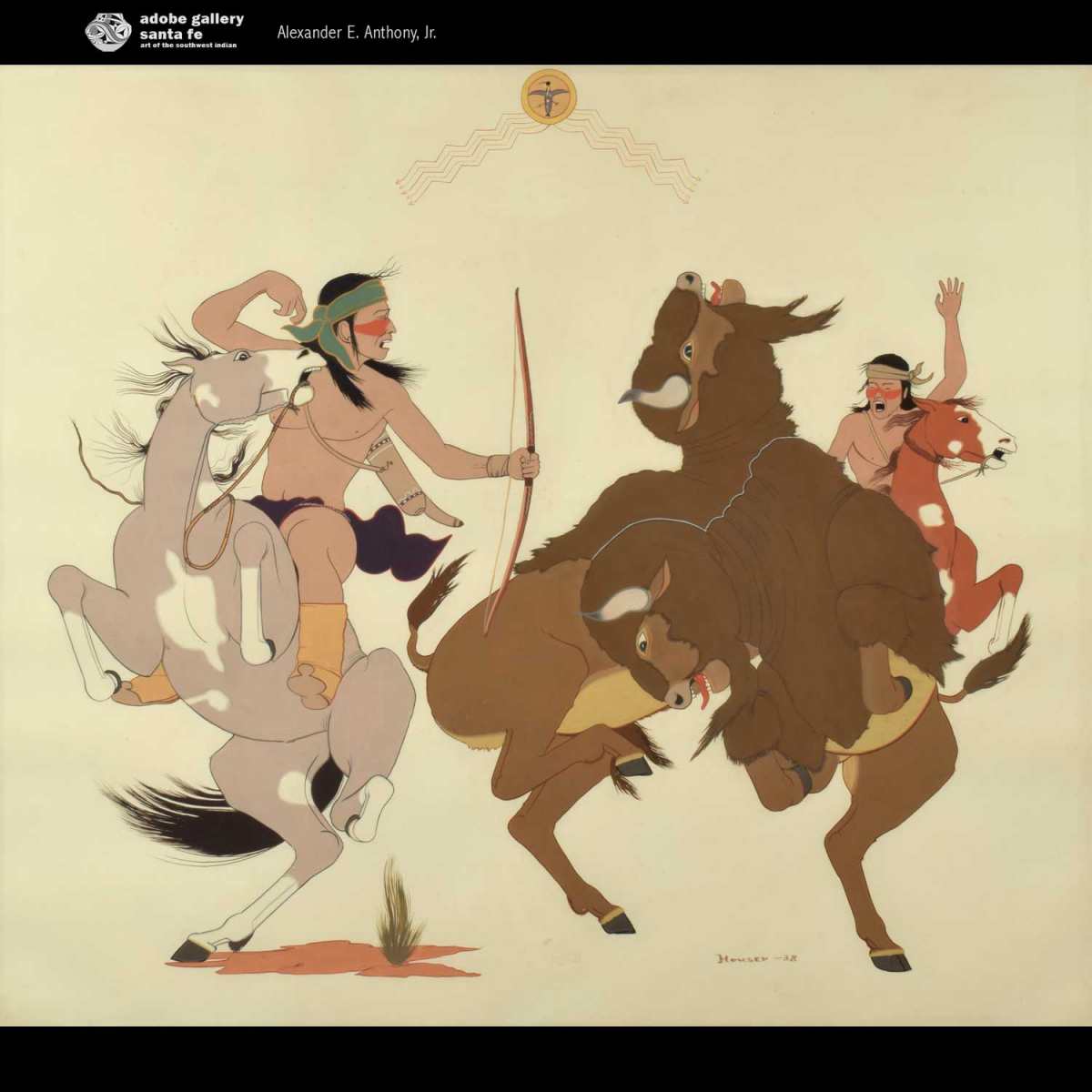
Original Painting of Buffalo Hunt dated 1938
Allan Houser (1914-1994) Haozous
watercolor
19 x 22 inches (L x W)
This wonderful untitled watercolor painting is signed and dated 1938. Included with the painting is a letter to the painting’s owner from a former Collection Manager for the Allan Houser Foundation. The letter, which was written in 1996, describes the piece as “an excellent example of Allan’s work from the period just after he graduated from The Painting Studio of the Santa Fe Indian School where he studied under Dorothy Dunn. You can clearly see the influence of that school in both the subject matter and technique of this piece.” This letter was written in response to a letter to Houser from the painting’s owner, which was found among Houser’s belongings after he passed away.
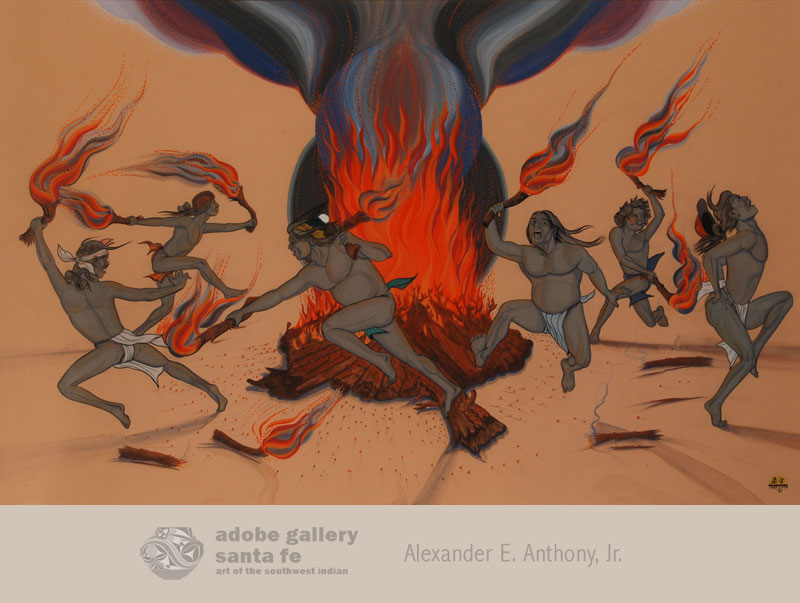
Original Painting of Fire Dance
Quincy Tahoma (1917-1956) Diné of the Navajo Nation
casein
18 x 28.5 inches (L x W)
The Navajo Fire Dance is a public dance performed at the end of the nine-day Mountain Chant. To start the dance, many young men drag great trees for a central fire, which rapidly turns into fierce flaring, crackling, and roaring heat. When it becomes its hottest, suddenly the loud burring call of the fire-dancers fills the air.
Quincy Tahoma (1917-1956) Water Edge - Near Water has presented the Fire Dance in a most accurate manner as performed by the group of young men. Tahoma, who normally painted muscular beautiful young men, chose to present these men in a more realistic manner with less than the perfect body. One young man is thin and not muscular, another is fatter with his stomach hanging over his belt. The men all have grey bodies, a result of smearing ashes over themselves. The faces of the young men show their seriousness in what they are doing. They are not playing around but are seriously carrying out the function of the dance.
The intense color in the painting comes from the fire the men are brandishing and the bonfire behind them. The powerful red fire and the shades of blue and grey smoke deeply impresses the viewer with the intensity of the heat. It makes one think “how do they do it, how do they contend with the heat?”
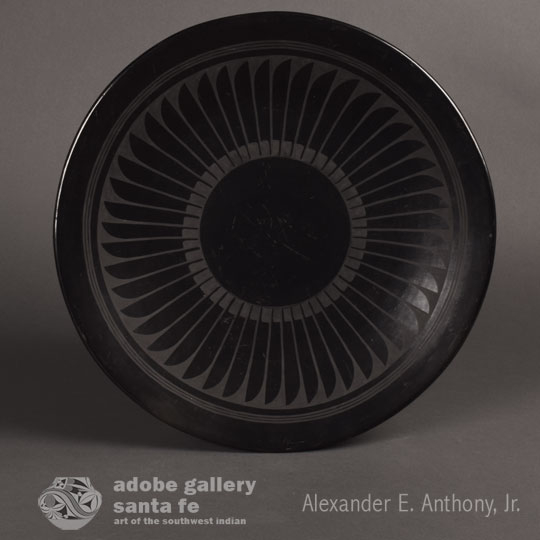
Very Large Black-on-Black Pueblo Pottery Plate
Maria Martinez (1887-1980) San Ildefonso Pueblo
clay
This is an enormous San Ildefonso Pueblo pottery plate by Maria Martinez, measuring over 14 inches in diameter. There are 48 feathers and three encircling lines near the rim. Each circle was painted freehand using a yucca leaf paint brush. The same process was used for outlining the feathers. It takes a steady hand to paint in that fashion and Santana was very good at doing so.
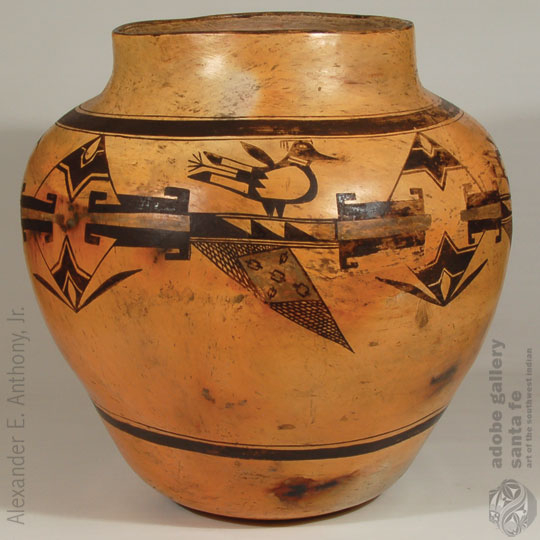
Very Large Hopi Polychrome Pictorial Storage Jar
Unknown Native Artist
clay, pigments
16.5 x 16.25 inches (L x W)
When a magnificent Hopi jar surfaces, the temptation is to try to assign the name of the maker. Most often, there are clues that lead one to select a maker—clues such as vessel shape, certain design elements, and age, perhaps—but it is not always so clear cut. We must discuss and analyze this magnificent jar on its own merits. It is large—larger than 16 x 16 inches—and this is not an easy feat to accomplish. After such a large jar is made and the design placed on, it must be fired, and that is where the danger lies. The jar must heat evenly or it could break or crack. To accomplish an even heat as the fire is started is quite problematic on a jar of this size. The design chosen by the potter is perfect for such a large pottery vessel. It is simple and uncluttered, yet is complicated and compact. There are large diamonds outlined in dark brown pigment, each of which has a dark brown design element at the top and bottom. The left and right points of the diamond have chain-like hooked elements that connect each diamond to a platform on which sits a bird—not just a bird, but a magnificent bird. This is a rare and extraordinary Hopi jar.

Very Large Magnificent Black Carved Jar
Margaret Tafoya (1904 - 2001) Santa Clara Pueblo
clay
17.5 x 14.5 inches (L x W)
Occasionally a black polished jar just takes one’s breath away. That was the effect this jar had on staff at the gallery and has had on clients who walk in to the gallery and see it. We all know that Margaret Tafoya was an amazing potter who produced large and magnificent wares, but, even so, it is still an emotional shock to see a jar that is so commanding of one’s attention because it is so visually magnificent and so elegant and regal. Those may be adjectives not normally ascribed to pottery but they are appropriate for this jar. At over 17 inches tall and 14 inches across, this jar makes a statement attesting to just how important it is.
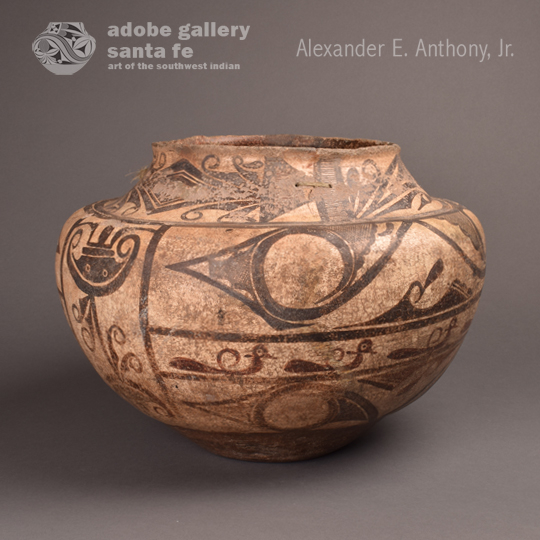
Well-Used Zuni Water Jar
Unknown Native Artist
clay, pigments
11 x 11.75 inches (L x W)
It has been determined that this jar dates to no later than 1870, based on several factors—the form of the jar has its widest dimension just slightly above the mid-section; there is a *puki depression on the brown underbody; the design on the body is a single continuous pattern rather than being divided into panels as on later jars; the simplified vertical pattern design is less elaborate that those after 1870; and the lack of a medallion in the design which appeared around 1870. These combined would indicate a date of 1870 or earlier.
The size of the jar, approximately 11 x 15 inches, is indicative of one made for home use, as jars made for sale through traders were generally smaller. The extensive wear patterns and the two native repairs on the neck back up this hypothesis. The jar shows extensive use patterns. It is quite likely one that was overlooked by the many museum authorities who were there collecting in the late 1800s or perhaps one that the owner refused to part with.
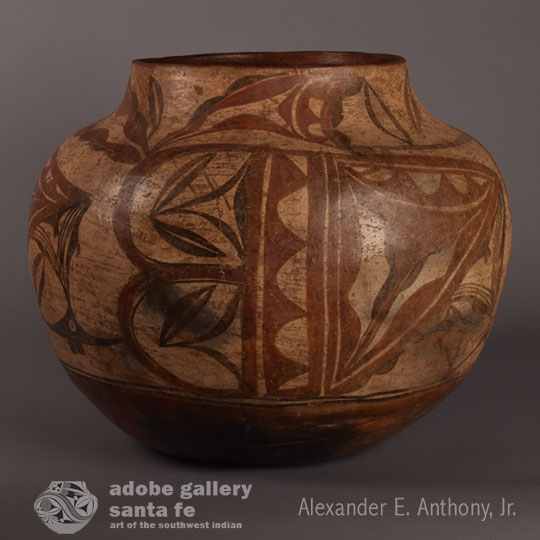
Zia Pueblo Storage Jar circa 1860
Unknown Native Artist
clay, pigments
15 x 17 inches (L x W)
One of the features of jars of the mid-1800s is the overall layout with no division between body and neck design. This is one of the defining characteristics of jars of this period. The maximum diameter of the body is just above the mid-point, the neck is just slightly concave, and the base is wide and flat. The red design elements are, for the most part, not outlined in black pigment. The lower body below the design is highly polished and has a wide wiped-on red band. The rim is red and the red flows into the interior rim. The design has a distinctive Santa Ana Pueblo influence.
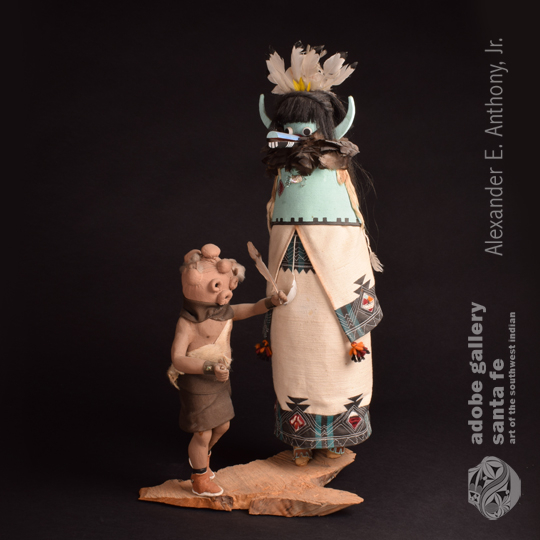
Zuni Pueblo Shalako and Koyemsi Katsina Doll Pair
Homer Sowtey - Zuni Pueblo
wood, fabric, feathers, paint, shell, hair
25 x 14 x 9 inches (L x W x D)
This version of the Shalako is a very good representation of the real Shalako. The hand-made clothing is well above average. What appears to be white linen clothing is embellished with elaborately overlaid painted fabric within which are embroidered designs representing Sun faces, Ojo de Dios, rain clouds and other symbols. A necklace of shell and turquoise beads hangs from the neck as do two fox fur pendants. A beautiful ruff of feathers surrounds the neck, and hair and feathers cover the head and hang down as hair behind the mask. The accompanying Mudhead is traditional in presentation with the knotted mask, black bandana around the neck, and a seed bag over his shoulder.
